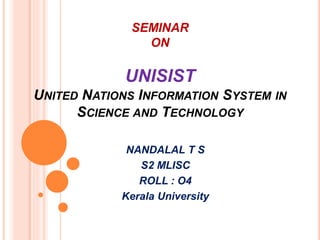
Unisist ppt
- 1. SEMINAR ON UNISIST UNITED NATIONS INFORMATION SYSTEM IN SCIENCE AND TECHNOLOGY NANDALAL T S S2 MLISC ROLL : O4 Kerala University
- 2. INTRODUCTION The UNISIST model of information dissemination was proposed in 1971 by the United Nations. UNISIST should play in the promotion of an international system for information covering science and technology. UNESCO is the parental body of UNISIST
- 3. ORIGIN UNESCO + ICSU { International Council of Scientific Unions } UNESCO / ICSU central committee . In January 1967 feasibility study for a world science information system. The feasibility study continued for about 4 years
- 4. 1970 the report entitled UNISIST study report on feasibility of a world science information system. The feasibility report was prepared by Jean Claude Gardin. This report and a synoptic version became the working document of the UNISIST inter governmental conference held in Paris in October 1971.
- 5. MILE STONES UNESCO / ICSU central committee 1967 UNISIST study report 1970 UNISIST inter governmental conference, 1971,paris
- 6. AIMS AND OBJECTIVES The ultimate goal or keynote of UNISIST are Establishment of a flexible and loosely connected network of information services based on voluntary cooperation. International cooperation and Development of scientific information policies and structure .
- 7. AIMS AND OBJECTIVES Assistance in developing countries in the development of scientific and technical information infrastructure To make strong and depth the knowledge of experts Strengthening the role of institutional components of the information transfer chain
- 8. ORGANIZATION 1. Intergovernmental conference responsible for approving UNISIST’s programme and reporting on their progress. 2. International scientific advisory committee. 3. Executive office serving as permanent secretariat of UNISIST.
- 9. ACTIVITIES Standards rules, principles and techniques: For the processing and transfer of information are adopted and applied internationally. Standardization of Bibliographic Description: Reference manual for machine readable bibliographic description
- 10. ACTIVITIES… Control of Serials and Abstracting / Indexing Periodicals: Computer based system of data bank to control over the periodical publications - International Serial Data System (ISDS). Broad System of Ordering (BSO): It has been conceived as a switching mechanism to link different individual classification and thesauri in the process of information transfer.
- 11. ACTIVITIES…. Handbook and Manual: A comprehensive handbook for scientific information and documentation services in developing countries has been planned. The handbook has been published in 1977. National Focal Point: Emphasis has been given to the creation of a focal point to scientific information agencies in each country.
- 12. Publications UNISIST published their newsletter quarterly. India at UNISIST The NISSAT advisory committee functions as the national committee of UNISIST in India.
- 13. UNISIST MODEL OF THE SOCIAL SYSTEM OF COMMUNICATION, WHICH CONSISTS OF 1) Knowledge producers 2) Intermediaries 3) Users The social system also contains institutes such as research institutes, publishers, and libraries. The actors and institutions perform information services such as writing, publishing, storing and retrieving documents and information.
- 14. THE UNISIST MODEL AND ITS BASIC CONCEPTS The UNISIST model offers an important sociologically-oriented perspective on the activities of scholarly communication. It seeks to draw attention to information communication between knowledge producer and knowledge user Examine communication and compare differences between them.
- 15. THE UNISIST MODEL AND ITS BASIC CONCEPTS In the UNISIST model, we observe three levels of information source services between the knowledge producers and users: 1) primary sources 2) secondary sources 3) tertiary sources
- 16. THE FLOW OF SCIENTIFIC AND TECHNICAL INFORMATION
- 17. CONCLUSION The UNISIST model is a fruitful model of scientific communication that help conceptualize IS. The model is also useful for practical information work. It is our hope that this model may stimulate further interest in scholarly communication and in documents and thus provide library and IS a much-needed theoretical inspiration.
- 18. REFERENCES UNISIST - Study Report on the Feasibility of a World Science Information System, By the United Nations Educational, Scientific and Cultural Organization and the International Council of Scientific Unions, Paris, UNESCO, 1971. Søndergaard, T. F.; Andersen, J.; Hjørland, B. (2003). "Documents and the communication of scientific and scholarly information: Revising and updating the UNISIST model". Journal of Documentation 59 (3): 278 UNISIST model - Wikipedia, the free encyclopedia
